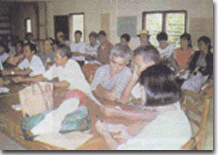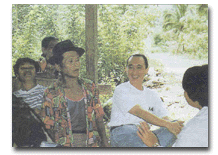 Weary of governmental deficiencies in water
resources planning and management, seven members/representatives of Kaabag sa Sugbo,
a local NGO network, met in December 1994. During this meeting, the idea of integrating
and broadening citizens’ participation in watershed management and planning were
discussed. The action was triggered by a number of concerns:
- the current water shortage and
imminent water crisis in Cebu;
- integrity of watershed areas in the
face of plans for development of a housing subdivision and golf course by a major real
estate corporation;
- the potential implications of (2) in
setting development precedents for the area;
- social considerations for the upland
farmers displaced by the aforementioned development project; and
- the termination of the Mananga
Watershed Development Authority (MWDA).
Sectoral fora, consultations and
dialogues were convened after that meeting to address the twin issues of water supply and
watershed management. Subsequently, a larger convenor group was created which organized a
multi-sectoral consultation. CUSW was formally launched on 25 January 1995. Media
exposure, public awareness, and community action proved instrumental in the conception and
birth of the Cebu Uniting for Sustainable Water.
 CUSW
defines its mission as the establishment of a more sustainable approach toward the
protection, management, and development of Cebu’s water resources. The Central Cebu
watersheds and the coastal aquifers are its primary areas of focus. Its immediate goal is
the formulation and institutionalization of an integrated water resources and land use
management plan for Central Cebu. CUSW
defines its mission as the establishment of a more sustainable approach toward the
protection, management, and development of Cebu’s water resources. The Central Cebu
watersheds and the coastal aquifers are its primary areas of focus. Its immediate goal is
the formulation and institutionalization of an integrated water resources and land use
management plan for Central Cebu.
Although noble in intent, CUSW was
immediately met with opposition from various sectors. A number of political leaders and
line agency personnel were lukewarm and non-committal. It has also encountered various
allegations of bias since its inception. It was initially regarded as
‘anti-development’ by the government agencies and business communities, and
‘anti-people environmentalists’ by some political leaders. Not fully aware of
the mechanics of the consultation, some sectors alleged that they were being excluded from
the process.
In the CUSW General Assembly on 07
April 1995, twenty-one sectors were identified as stakeholders. Individuals or
organizations were designated to represent each of the sectors in various consultation and
fora. After the first multi-sectoral consultation and the succeeding dialogues,
sectoral positions, interests and views on watershed management were discussed and
documented. These results were then synthesized into what later became the 12-point
framework for watershed management and land use masterplan. During the recent General
Assembly on 13 October 2000, more sectors were identified among which are local government
units, urban people's organizations/residents, professionals, youth/students, women,
academe, business, religious, national line agencies, farmers, fisherfolks, civic,
cooperatives, non-government and peoples organizations, protected areas management boards,
and media.
The Organization
The Board of Trustees is CUSW’s
highest policy-making and governing body. A Coordinating Council, which meet on a
quarterly basis, is composed of elected sectoral representatives and serves as the link
between CUSW Board of Trustees and member-organizations within a specific sector. There
are seven Working Committees open for membership, namely: 1) Information, Education and
communications; 2) Special Projects; 3) Research and Planning; 4) Legal and Development
Administration; 5) Resource Mobilization and Fund Raising; 6) Monitoring and Evaluation;
and 7) Membership Involvement. CUSW organizes a series of internal strategic
planning sessions and regular meetings to map directions and operationalize its goals and
activities.
Figure 1: CUSW Organizational Chart
Except for the full-time Secretariat, all the members
working for the coalition are volunteers. Regular revenues are generated from membership
fees. It receives financial assistance from different sources such as Ford Foundation,
Ramon Aboitiz Foundation, Inc., among others, for various projects/activities.
Resolving Conflicts
Mediation in natural resources and environmental conflicts
is a relatively "new" approach in resolving disputes in the Philippines, since
there are few professionally trained or certified mediators. The normal response to
dispute situations is to seek efforts toward conciliation and harmonization. In general,
family-level conflict is resolved through the intervention of an elder respected person,
usually a man, who steps in the height of a dispute and pacifies "warring"
parties. When transposed to a higher level of conflict, these efforts require the
personality of a religious or political leader as third party arbiter and mediator.
In Cebu’s water conflict, attempts have been made to
bridge differences where there are clearly divergent views and interests,. Arguments
initially focused on several technical understanding of the implications of development
activities. During that time, most of Cebu community did not have a clear understanding of
the concept of "watershed". There was an obvious need to address this, thus IEC
(information, education and communication) on watershed and watershed management was
prioritized. A series of fora and field trips to watersheds were conducted. Its initial
participants were the NGO community, the business community, and the media, and was later
expanded to the greater population.
Recognizing the importance of using accurate and reliable
information in the planning process and as a tool in bridging conflict, efforts were made
to find ways and means to raise political, moral, financial, and technical support for the
conduct of multi-disciplinary studies and community validations. To enhance its technical
capabilities, and at the same time promote networking, CUSW participates in local,
national, and international trainings, seminars, workshops, and conferences.
The political leadership, during the
early stage of CUSW, neither expressed opposition to the call for a watershed masterplan
nor offered any support for the plan. The CUSW members recognized that the landuse
planning process would help rationalize varying interests, which can serve as a
mediation-conflict resolution mechanism.
It was then decided that lobbying and advocacy efforts should be centered on the need for
a process of formulating a comprehensive masterplan. Support from local, national, and
international groups was sought for the technical planning and financial assistance for
the process. mechanism.
It was then decided that lobbying and advocacy efforts should be centered on the need for
a process of formulating a comprehensive masterplan. Support from local, national, and
international groups was sought for the technical planning and financial assistance for
the process.
The CUSW
Now
The CUSW ultimately assumed the role
of facilitator-convenor- mediator, although it was not seen that way in its early stage.
It gradually evolved into a forum where varying interests and opinions could be discussed
by various stakeholders, with water supply and watershed management as its point of
convergence.
With ‘sustainable water’
as its unifying agenda and the corollary of improving the quality of life, the support
that CUSW is getting has been gradually increasing. It has now become the partner of the
City Government in the formulation of the Cebu Water Resources and Land Use Master Plan.
It also has successfully developed apparent alliances between landowner-residents and
non-resident landowner-real estate developers, and landowner-developers with key political
leaders. Through dialogue and diplomacy, networking and linkaging, relationships have been
bridged and various sectors are slowly gaining trust and confidence with each other. The
Cebu populace is now working together towards the achievement of the planning goal. While
steps have been taken to address the conflict over water supply and watershed management,
the problem is far from over. The process is still very much an on-going effort.
basic info
| coalition
| strategy
| critical factors
| other links
| home
|

